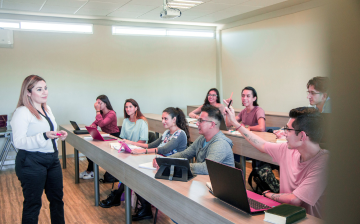
Risk Management Class for Students: What to Expect
Risk Management Class for Students: What to Expect
Risk has become omnipresent in today’s fast-changing and unpredictable world. Risks emerge in financial markets, supply chains, cyber threats, and the environment. For students entering this field, the ability to identify, analyse, and mitigate risks has become an essential skill.
A risk management class offers more than academic study. It provides practical tools for decision-making and problem-solving.
Whether you are a business student, a future finance professional, or simply curious about organisational resilience, a risk management course provides deep insight. Let’s explore the benefits.
Building Strong Foundations in Risk
The first stage of risk management courses focuses on building core knowledge. Students develop a clear understanding of what risk means in different contexts. You will study:
- Types of risk: financial, operational, strategic, reputational, and compliance.
- Key principles: probability, exposure, uncertainty, and tolerance.
- Risk versus uncertainty – a crucial distinction guiding decision-making.
This foundation ensures students from diverse backgrounds—economics, engineering, law, or liberal arts—can communicate in a shared language of risk.
Exposure to Global Frameworks
Courses introduce internationally recognised frameworks such as:
- ISO 31000 – outlining principles and guidelines for risk management.
- COSO ERM Framework – widely used for enterprise risk governance.
- Basel Accords – influential in banking and financial regulation.
These frameworks help organisations structure policies, remain compliant, and strengthen accountability.
Practical Risk Assessment Tools
Risk cannot be managed through theory alone. Modern courses are tool-intensive and hands-on. You will gain exposure to:
- Risk matrices – ranking threats by likelihood and impact.
- SWOT and PESTLE – analysing internal and external influences.
- Scenario planning – preparing for possible future outcomes.
- Quantitative models – such as Value at Risk (VaR) and Monte Carlo simulations.
Case studies often demonstrate these methods in action, helping students connect classroom learning with real-world practice.
Real-World Case Studies and Simulations
Understanding risk is easier when you see it applied. Courses often analyse corporate case studies such as:
- The 2008 global financial crisis.
- Cybersecurity breaches at major corporations.
- Supply chain disruptions during the pandemic.
Some programmes go further, offering simulations where students act as decision-makers. These exercises help you:
- Respond quickly to urgent challenges.
- Collaborate with peers to solve problems.
- Balance strategy with time-sensitive decision-making.
This approach bridges the gap between theory and practice.
A Cross-Disciplinary Perspective
Risk exists in every domain—finance, operations, IT, marketing, and strategy. Strong courses highlight links across disciplines, such as:
- How economic trends affect market risks.
- The impact of compliance laws on operations.
- The risks and opportunities created by emerging technologies.
This broad perspective prepares students for careers in diverse sectors.
Focus on Communication and Reporting
A great analysis has little value if stakeholders cannot understand it. Risk management courses place emphasis on communication skills, teaching students to:
- Write clear, concise reports.
- Present assessments to senior management.
- Use visuals such as dashboards and heat maps.
This ability is highly valued in workplaces where leaders must act quickly.
Awareness of Emerging Risks
Modern courses focus not only on today’s risks but also on tomorrow’s challenges. Students gain awareness of:
- Climate and sustainability risks.
- Geopolitical tensions and trade disruptions.
- Cybersecurity and data privacy concerns.
- Automation and artificial intelligence risks.
This forward-looking knowledge helps professionals remain relevant and adaptive.
Opportunities for Collaboration and Networking
Risk management is rarely a solo activity. Most programmes encourage group projects, debates, and team-based problem-solving. Students benefit from:
- Exposure to diverse perspectives.
- Building teamwork skills.
- Developing a network of peers and professionals.
These connections often prove valuable during internships and future careers.
Comprehensive Evaluation Methods
Assessment in risk management courses is varied and practical. Common formats include:
- Written case study analysis.
- Group simulations and team projects.
- Individual presentations of risk assessments.
- Short tests on theory and tools.
This approach rewards applied problem-solving rather than rote memorisation.
The Importance of Risk Management Certification India
The past few years have shown how sudden disruptions—pandemics, financial crises, or political conflicts—can reshape entire industries overnight. Organisations now demand professionals who can anticipate, manage, and respond to such challenges.
Risk management education is no longer an optional extra for a student’s CV. It is a competitive advantage in the job market.
Employers value graduates who not only understand risk theory but also apply it ethically and strategically. Increasingly, risk management has become a leadership skill essential for long-term success.
Summary: Pathway to Professional Excellence with GRMI
For those seeking advanced expertise, specialised programmes take learning to the next level. One standout institution is the Global Risk Management Institute (GRMI) in India.
GRMI offers a Post Graduate Diploma in Risk Management (PGDRM) designed to provide end-to-end expertise. It covers global regulations, emerging technologies, and advanced analytical tools. Key highlights include:
- Curriculum aligned with industry needs and designed by global risk experts.
- Hands-on learning through internships, live projects, and case studies.
- Distinguished faculty with global industry backgrounds.
- Opportunities to connect with senior executives and a strong alumni network.
For students who have completed an introductory risk management course, GRMI’s PGDRM is a decisive next step towards careers in finance, consulting, operations, and enterprise strategy.
FAQ’s
Q1: Who is eligible to enrol in a course on risk management?
Ans: Graduates in a variety of disciplines, such as business, economics, engineering, law, and information technology, are eligible to enrol in risk management courses.
Q2: What abilities are imparted by these courses?
Ans: They gain proficiency in communication, risk analysis, decision-making, and the application of international frameworks such as COSO and ISO 31000.
Q3: What is the typical duration of risk management courses?
Ans: While higher diplomas like GRMI’s PGDRM take around a year to complete, introductory courses may last a few months.
Q4: After finishing a course, what employment options are available?
Ans: Graduates can look into careers in enterprise strategy, cybersecurity, operations, consulting, finance, and compliance.
Q5: What makes GRMI a popular option?
Ans: The industry-aligned curriculum, international faculty, practical projects, and robust corporate network are what make GRMI unique.
Best Course After Graduation? Here’s What Top Recruiters Recommend in 2025
You may also like

How to Choose the Best Cybersecurity Course in Delhi for Your Career

PG Degree for Housewives & Career Re-Starters: A New Beginning


